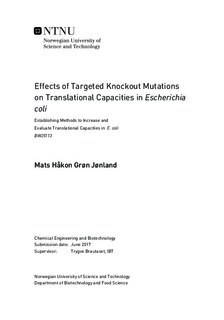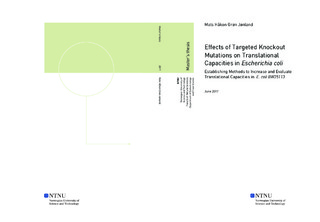| dc.description.abstract | The overall aim of this thesis was to investigate how genome engineering might be used to generate Escherichia coli strains with increased capacities for recombinant protein production. As translation constitute a possible bottleneck in recombinant production processes [Mahalik et. al, 2014] this work focused on evaluating and increasing translational capacities in E. coli.
Two methods were used to evaluate translational capacities in E. coli:
1. Two plasmid reporter systems were established to investigate levels of ribosome expression. These plasmids carried red fluorescent protein genes (mCherry), under control of ribosomal promoters. Levels of expression of ribosomal constituents were evaluated by measuring fluorescence from strains carrying reporter plasmids.
2. Exponential phase growth rates were used to assess translational capacities. Protein synthesis is generally the growth rate limiting factor during exponential phases, and a positive linear correlation between growth rates and ribosome concentrations have been observed in earlier work [Forchhammer & Lindahl 1971; Bremer & Dennis 1996; Scott et al 2010; Klumpp et. al, 2013].
The plasmid based reporter systems were characterized and verified as reliable reporters for levels of ribosome expression in wild type E. coli BW25113. However, fluorescence readings were only deemed reliable when evaluated qualitatively.
In an effort to increase translational capacities in E. coli BW25113, three genes were knocked out (uspA, dps and ompA). The general rationale of this approach was that by knocking out non-essential genes, cells can more efficiently allocate resources towards growth or recombinant protein production.
A set of single gene knockout mutants in which the target genes (uspA, dps and ompA) had been replaced with kanamycin resistance cassettes were received from the KEIO collection [Baba et. al, 2006]. None of this gene substitution mutants were deemed to have increased translational capacities, compared to wild type E. coli BW25113. This was explained by the notion that these strains did not have significantly reduced proteome sizes, as genes were replaced not removed.
A set of single gene deletion mutants were generated by removing the kanamycin resistance cassettes from the strains from the KEIO collection. Deletion of the ompA gene resulted in enhanced levels of ribosome expression and a 6±4% increase in cell growth rates. Hence, it was concluded that ompA deletion mutants had increased translational capacities compared to wild type E. coli BW25113. OmpA is an abundant protein in fast growing E. coli cells. The observed increased in translational capacities in ompA deletion mutants were accredited to the notion that these strains had significantly smaller proteomes than wild type cells. Dps and UspA are stress related proteins, and constitute only small parts of the E. coli proteome during exponential phase growth. Gene deletions of uspA or dps did not result in increased translational capacities in E. coli BW25113.
The results obtained in this work suggest that introduction of targeted knockout mutations is a valid strategy for increasing translational capacities in E. coli. Genes that are highly expressed during exponential growth phases should be targeted for deletion mutations for this approach to be effective.
To generate strains with significantly increased capacities for recombinant protein production it is most likely necessary to introduce multiple targeted knockout mutations. In this work, CRISPR optimized MAGE recombineering (CRMAGE) [Ronda et. al, 2016] was evaluated as a possible method for generating multiple knockout mutations in the E. coli genome. A ∼4% mutation efficiency was achieved when utilising this method. This was very low compared to earlier work (∼98%) [Ronda et. al, 2016] and further optimization is probably necessary before this method can be efficiently used to knock out genes in our labs. | |

